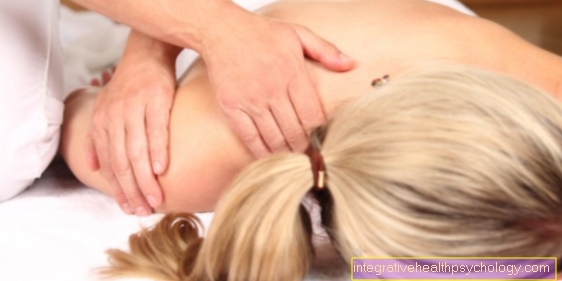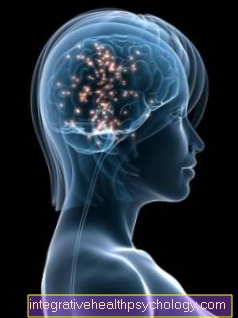Causes of Lumboischialgia
What is lumbar sciatica?
Lumboischialgia is not a disease, but the description of a symptom, the back pain that passes into the leg.
Lumboischialgie is made up of the terms lumbalgia = back pain in the lumbar spine and sciatica = leg pain transmitted via the sciatic nerve.
Get more information about symptoms or treatment options Lumboischialgia

Herniated disc as the most common cause of lumbar sciatica
Lumboischialgia can have several underlying causes. By far the most common cause of disease is a herniated disc in the lumbar spine.
The herniated disc tissue in the direction of the spinal cord leads to chemical and mechanical irritation of the outgoing nerve roots and / or the spinal cord. This causes nerve root pain (Radiculopathy) that runs along the affected body nerve (peripheral nerve) continues into the body. Since the lower spinal cord nerves of the lumbar spine unite to form the largest human body nerve, the sciatic nerve, pain is transmitted in lumbar sciatica along the sciatic nerve via the buttocks, the back thigh, the lower leg and into the foot.
In the case of the cause of lumbar sciatica, there is a connection between the strength of the nerve root irritation in the spinal column area and the extent of the pain in the leg. The stronger the irritation (Charm) the nerve root, the further the pain is directed along the sciatic nerve into the leg. Very strong nerve root irritations lead to leg pain up to the foot, less severe nerve root irritations lead to leg pain that can break off in the upper or lower leg area. Typically, in lumbar sciatica, the back and leg pain caused by a herniated disc is more pronounced in the patient's leg than in the back.
If you suspect a herniated disc as the cause of your lumbar sciatica, we recommend our topic: Herniated disc on the lumbar spine
Less common causes of lumbar sciatica
Less common causes of lumbar sciatica are wear-related narrowing of the nerve exit holes on the spine (degenerative spinal disease), vertebral joint cysts or inflammation of the sciatic nerve itself.
Pseudoradicular back pain
Pseudoradicular pain must be differentiated from the causes of lumbar sciatica. This refers to simulated nerve root pain that can be caused by various diseases. Pseudoradicular back pain also radiates into the leg, but never reaches the foot and cannot be assigned to any nerve root. The following diseases can cause pseudoradicular back pain:
- Facet syndrome
- Diseases of the sacroiliac joint (SI joint)
- "Blockages" of the lumbar spine
- Muscular tension
Appointment with a back specialist?

I would be happy to advise you!
Who am I?
My name is dr. Nicolas Gumpert. I am a specialist in orthopedics and the founder of .
Various television programs and print media report regularly about my work. On HR television you can see me every 6 weeks live on "Hallo Hessen".
But now enough is indicated ;-)
The spine is difficult to treat. On the one hand it is exposed to high mechanical loads, on the other hand it has great mobility.
The treatment of the spine (e.g. herniated disc, facet syndrome, foramen stenosis, etc.) therefore requires a lot of experience.
I focus on a wide variety of diseases of the spine.
The aim of any treatment is treatment without surgery.
Which therapy achieves the best results in the long term can only be determined after looking at all of the information (Examination, X-ray, ultrasound, MRI, etc.) be assessed.
You can find me in:
- Lumedis - your orthopedic surgeon
Kaiserstrasse 14
60311 Frankfurt am Main
Directly to the online appointment arrangement
Unfortunately, it is currently only possible to make an appointment with private health insurers. I hope for your understanding!
Further information about myself can be found at Dr. Nicolas Gumpert
Facet arthrosis
Facet arthrosis is arthrosis between the vertebral bodies. In the majority of cases, facet arthrosis occurs in the lower area of the spine, i.e. in the area of the lumbar vertebrae.
The cause of facet arthrosis lies in the increased wear and tear of the vertebral bodies and the intervertebral discs between them. In comparison to the usual herniated disc, the wear and tear is localized in the rear area of the vertebral bodies.
A vertebral body has an extension in its rear area that protrudes upwards and one that protrudes downwards. The joints that are located between two vertebral bodies lying one above the other are the so-called facet joints.
The wear and tear on the facet joints is often caused by years of heavy physical exertion. Being very overweight is also a risk factor for facet arthrosis.
The ongoing overloading of the spine can over time lead to increased wear and tear on the affected cartilage and vertebral joints. Cysts, joint inflammation or spinal canal stenosis can also lead to facet arthrosis.
Facet arthrosis can also be a specific consequence of a herniated disc. In the case of a herniated disc, the distance between the vertebrae is reduced. As a result, the facet joint between the vertebral body processes cannot perform its function properly. This can lead to increased wear and tear on the joint and thus to facet arthrosis.
ISG blockage
Pain in the lower area of the spine that radiates into the buttocks does not always have to be caused by a herniated disc or lumbago. Often the cause of such complaints is a blockage of the joint between the sacral spine and the back of the pelvis, a sacroiliac joint blockage.
The causes that lead to a blockage of the joint are many. Usually the pain is caused by the displacement of the bones that make up the gelemk. As a result, part of the joint slides out of the joint space and restricts movement. The irritation of the joint capsule surrounding the joint ultimately leads to a sensation of pain and, in particular, to joint inflammation.
There may be different causes for such a displacement of the sacral spine and the pelvis.
- Short, jerky movements
- Muscles that are too weak
- Obesity
- Bechterew's disease (chronic inflammatory disease)
- Pregnancy (hormonal changes lead to the loosening of the ligaments that are normally supposed to stabilize the joint)





























